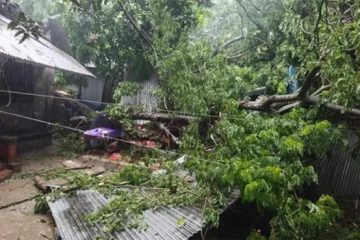CNG yet to be recognised as power source
 Strange it may sound, but the existing Motor Vehicle Ordinance (MVO),1983, has yet to recognise Compressed Natural Gas (CNG) as a power source for vehicles! No matter what the authorities think, for the past eight years, about 65 per cent of the country’s vehicles have been running on CNG. Although 34 amendments have been made in the MVO over the years, the ordinance still has no rules and regulations concerning CNG-driven vehicles. Thus, these vehicles do not fall under mandatory fitness inspection.
Strange it may sound, but the existing Motor Vehicle Ordinance (MVO),1983, has yet to recognise Compressed Natural Gas (CNG) as a power source for vehicles! No matter what the authorities think, for the past eight years, about 65 per cent of the country’s vehicles have been running on CNG. Although 34 amendments have been made in the MVO over the years, the ordinance still has no rules and regulations concerning CNG-driven vehicles. Thus, these vehicles do not fall under mandatory fitness inspection.
The Independent found that in 2007 the Bangladesh Energy Regulatory Commission (BERC) had prepared a draft act on “Safety codes and standard for CNG-fuel systems for vehicles”. Even after four years, the draft is still caught in bureaucratic red tape.
By this time, lack of rules and regulations for CNG-driven vehicles has induced nearly 80,000 vehicles across the country to ply with faulty and outdated gas cylinders without necessary hydro-static tests, a must for such vehicles.
In the absence of regulatory authorities, most CNG refuelling stations use below par machineries, cutting down benefits of these vehicles. Instead of putting a check to air pollution, such malpractices have actually increased the level of suspended particulate matter (SPM) in the environment.
Citing the ancient MVO, the Bangladesh Road Transport Authority (BRTA) has long been evading its responsibility to check the fitness of CNG-driven vehicles. And its “hands off” for the Rupantarita Prakritik Gas Company Limited (RPGCL) because the amended CNG Conversion Safety Act 2005 exempts the RPGCL from monitoring vehicles after their conversion to natural gas.
The department of explosives, under the energy and mineral resources division, in the power, energy and mineral resources ministry stated that its duty is to ensure safety during the conversion process and to form a probe committee to conduct investigations in case of a cylinder explosion.
According a study of the Dhaka Transport Coordination Board (DTCB), the CNG concept was first introduced in Bangladesh in 1982 under a project funded by the World Bank. But it got a major boost in 2002.
The DTCB study stated that the number of CNG vehicles was 6,500 in 2002, which rose to 0.2 million in 2010. There were five CNG conversion workshops and 12 CNG refuelling stations in 2002, whereas in 2010 the numbers rose to 177 and 324, respectively.
A report by Akhtar Hossain Babu, chief executive and environmental consultant of the Society for Urban Environmental Protection (SUEP), showed that eight out of 10 CNG-converted vehicles emit 7-12 per cent of carbon monoxide owing to lack of poor conversion and maintenance.
Babu told The Independent that during conversion, engines are tuned to keep a proper ratio of air and gas in the combustion chamber. “This tuning needs periodical re-checking. However, as there is no one to check the combustion ratio, carelessly converted CNG-driven vehicles emit harmful suspended particulate matter (SPM),” Babu added.
A separate study by Anumita Roy chowdhury, executive director of the Centre for Science and Environment (CSE), a New Delhi-based environmental research organisation, stated that introduction of the CNG helped save 4,260 premature deaths in 2003 in Dhaka as the air got cleaner. In an e-mail to The Independent, she wrote that as Bangladesh had not formed proper rules and regulations for CNG-vehicles, mainly private modes of transport took the advantage of using relatively cheap CNG and evaded the mandatory checking of engines.
M Khaliquzzaman, environmental scientist of the World Bank (WB,) told The Independent that after the large-scale CNG conversion began at the end of 2002, the WB conducted a study in 2003 and found that the air of all metropolitan cities had significantly become cleaner.
But he said that while the pricing policy has given the CNG a significant advantage over the fossil fuel because of which the conversion
boom started, no regulation policy has been put in place to monitor the whole scenario.
“The DTCB formed a Road Transport and Traffic Act (RTTA) 2011. It has the provision for rules and regulations for CNG-run vehicles. Hopefully, it will replace the MVO,” he said.
Anisur Rahman, project director of the DTCB, told The Independent that the draft RTTA has now 19 chapters, replacing 11 chapters of the MVA 1983. “In the RTTA, CNG is properly defined as transport fuel in chapter two, and all sorts of necessary rules and regulations for CNG-converted vehicles are stated in the draft,” he added.
Rahman said that currently the RTTA is reviewed by different authorities, including the BRTA, ministry of communication, ministry of power energy and mineral resources, ministry of finance, traffic division of Dhaka Metropolitan Police (DMP) and BUET. “Hopefully the draft will be passed soon and there will be proper rules and regulations for the CNG-driven vehicles”, he added.
Hasin Parvez, country representative of the Asia Pacific Natural Gas Vehicles Association (ANGVA), told The Independent that ANGVA green highways 2011, an initiative to promote NGVs across Asia, will pass through Bangladesh on October 5 (Tuesday). “Bangladesh is one of the few countries having more than 60 per cent of NGVs.This is a significant improvement. All we need is a proper rule to get the benefit of such a environment-friendly vehicles,” he added.
Courtesy of The Independent




















